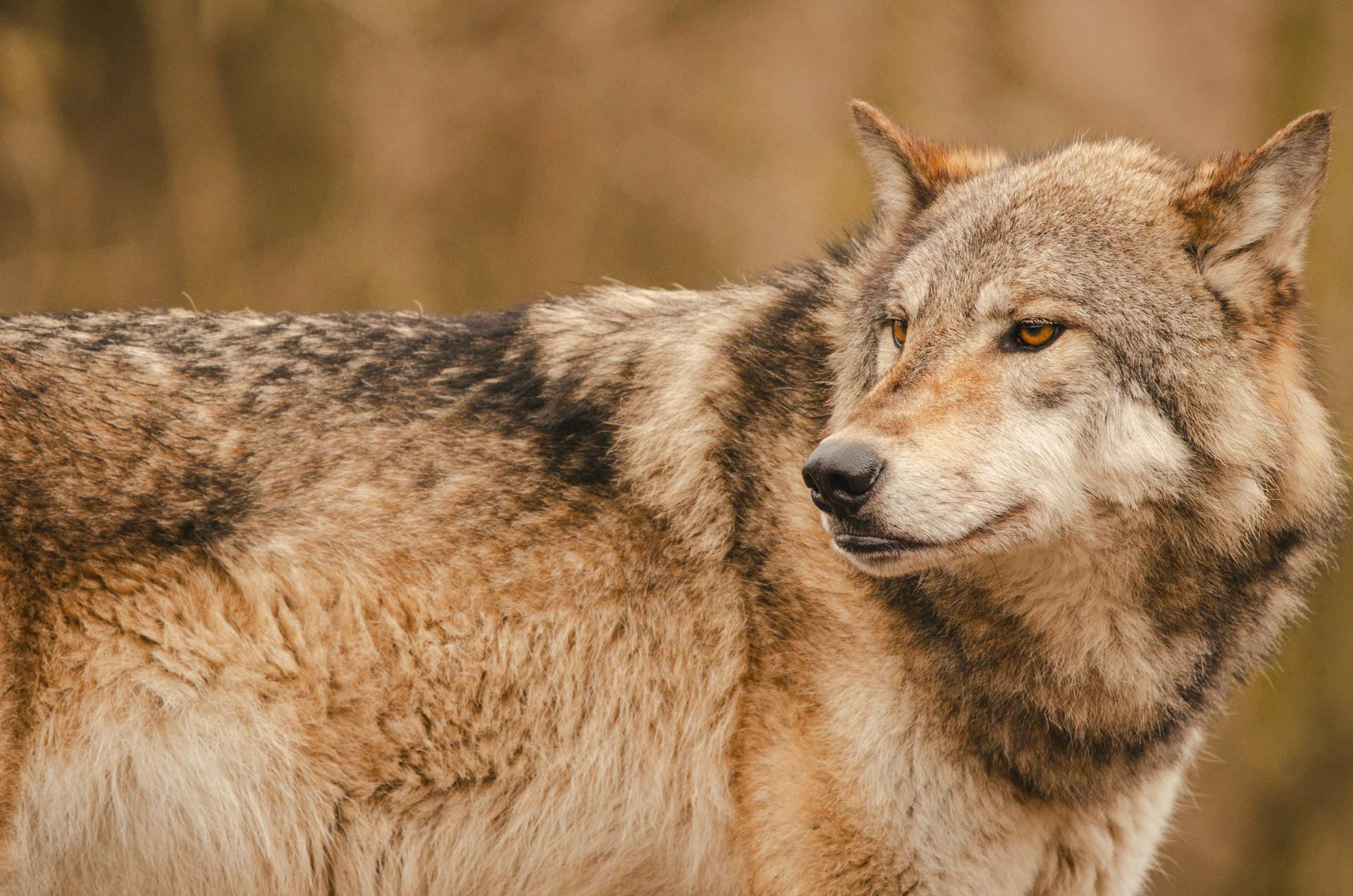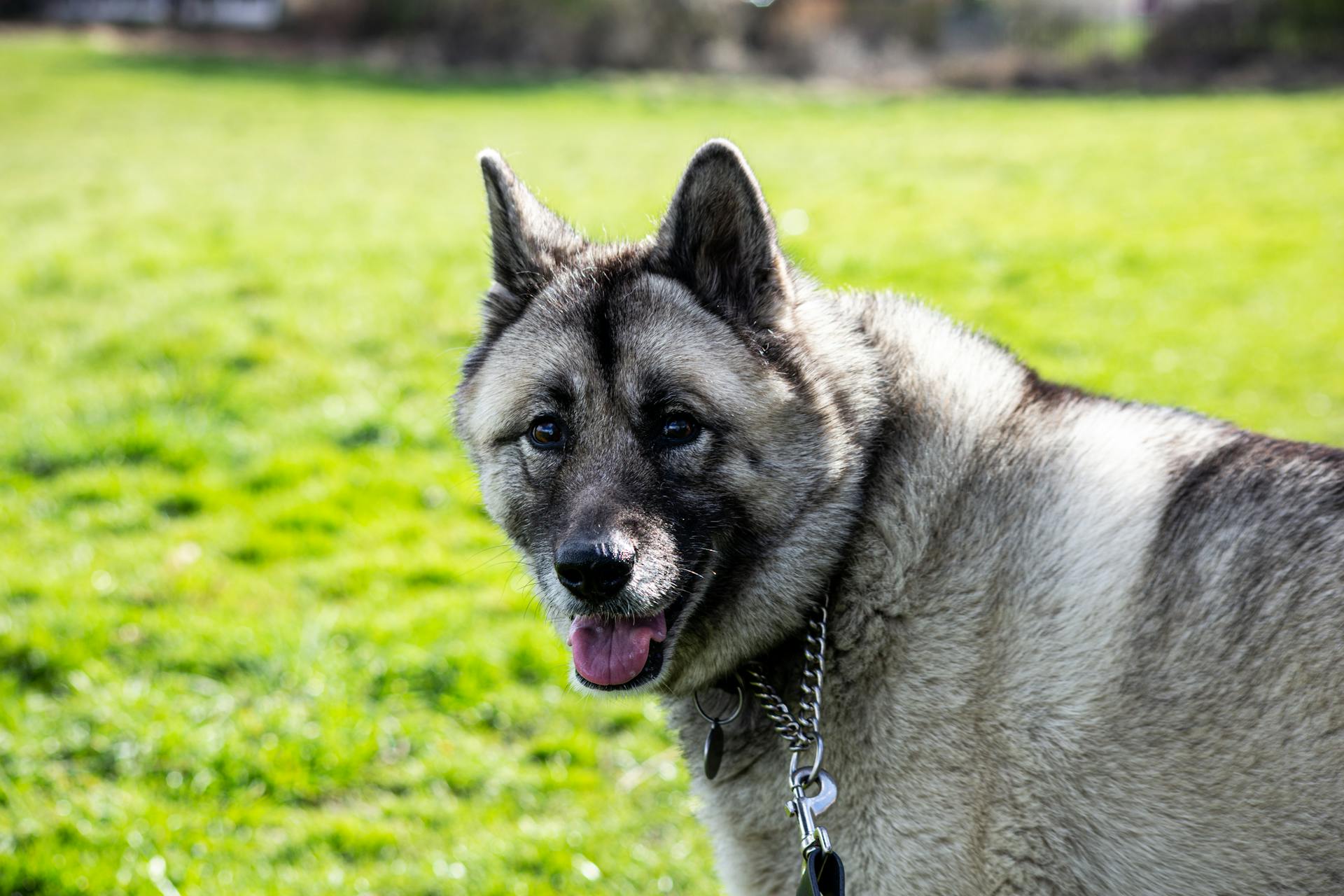
Wolf hybrids can be quite expensive, with prices ranging from $1,000 to $10,000 or more, depending on factors such as bloodlines, age, and breeder reputation.
These costs don't even account for the long-term expenses of caring for a wolf hybrid, which can live up to 16 years in captivity.
Wolf hybrids require a lot of space to roam, and their enclosures need to be escape-proof and secure to prevent them from getting loose.
A suitable enclosure for a wolf hybrid can cost upwards of $5,000 to $10,000 or more, depending on the size and materials used.
Wolf hybrids also have specific dietary needs, and their food can be quite expensive, with some owners spending upwards of $100 per month on high-quality meat and supplements.
Explore further: Are Huskies Wolf Hybrids
What Are Wolf Hybrids?
Wolf hybrids, also known as wolfdogs, are animals that are part wolf and part dog. Both species share an evolutionary past, making them very physically and behaviorally similar.
There isn't a breed standard for wolfdogs, so enthusiasts use the term "content" to refer to the wolf-to-dog genetic ratio of a specific animal. This means that a low-content wolf-dog hybrid will display more dog traits than wolf traits.
Experts suggest that in nature, wolfdogs are extremely rare, as wolves are territorial and monogamous animals. They usually won't react well to dogs being near them or their territory.
Many people seek to get a wolf-dog hybrid for security purposes, thinking a wolf will be able to defend them better than an average dog. However, wolf-dog hybrids usually make for worse guard animals than most dog breeds.
Types of Wolf Hybrids
Wolf hybrids can be tricky to define due to the lack of a clear definition, but most experts agree that a wolfdog is an animal with a pure wolf in its family, no more than four or five generations back.
There's no way to prove an animal's pedigree, as there is no breed registry for wolves or wolf hybrids.
You might like: Pictures of Wolf Hybrids
Wolf Hybrid Care and Management
Wolf hybrids require a strict diet consisting of mostly raw meat, bones, and nutritional supplements, which can cost over $5,000 a year.
Their partially-wild nature makes them prone to stress, which can harm them physically and mentally. They have neophobic tendencies, meaning they'll be afraid of new experiences.
Wolfdogs need large enclosures and a considerable amount of exercise due to their size, which can vary depending on their ancestry. They resemble large dogs in size.
If you're considering getting a wolfdog, you'll need to install an expensive, large, and escape-proof enclosure in your home. You'll also need to have a similarly-sized dog to keep them company.
Wolfdogs are shy animals and can be prone to aggression, especially during seasonal behavioral changes like "Winter Wolf Syndrome." This can make them potentially violent and aggressive creatures.
Here's a breakdown of the estimated annual costs of caring for a wolf hybrid:
Keep in mind that these costs are estimates and can vary depending on your location and the specific needs of your wolf hybrid.
Wolf Hybrid Breeding and Admixture
Experts agree that many "wolfdogs" being sold or kept as pets are actually just mixed breeds with little to no wolf content. This is often due to uneducated buyers who don't know what to look for in a wolfdog.
The majority of wolfdogs being kept as pets are actually all dog, with some breeders mislabeling mixed breeds as wolfdogs to take advantage of the high price tag. These animals can fetch up to $2,500 apiece.
Admixture between domestic dogs and gray wolves is the most common type of wolfdog, as dogs and gray wolves are genetically very close and have shared ranges for millennia. This has resulted in many populations with dog-wolf admixture in the wild.
Some recognized wolfdog breeds include the Czechoslovakian Wolfdog and the Saarloos Wolfdog, which were developed through intentional breeding programs.
If this caught your attention, see: Wolf Dogs as Pets
Mislabeled Mixed Breeds
Many so-called "wolfdogs" are actually just mixed breeds, with little to no actual wolf content. Experts estimate that 70 percent of "wolfdogs" kept as pets are not wolfdogs at all.
Some breeders are selling "high content wolf dogs" for up to $2,500 apiece, despite having little or no wolf ancestry. This is a major issue, as many people are unknowingly buying these mislabeled animals.
Individuals are taking dogs like Malamutes and Shepherds and breeding them until they get an animal that resembles a wolf. This is often done to cash in on the popularity of wolf hybrids.
The Saarloos Wolfdog
The Saarloos Wolfdog was created in 1932 by Dutch breeder Leendert Saarloos, who crossed a male German Shepherd dog with a female European wolf.
This unique breeding process led to the development of a hardy, self-reliant companion and house dog.
The breed's originator, Leendert Saarloos, aimed to create a dog that could thrive in various environments with minimal human intervention.
The Dutch Kennel Club recognized the breed in 1975, and in honor of its creator, they changed the name to the Saarloos Wolfdog.
The breed's recognition by the Fédération Cynologique Internationale (FCI) in 1981 further solidified its place among recognized dog breeds.
Check this out: Wolf Dog Cross Breed
Volkosob
The Volkosob is a wolf hybrid breed that was developed in the 1990s in Russia.
Russian border guards created the breed by breeding a Caspian Steppe Wolf with German Shepherds of an East European Shepherd line.
The goal was to create a dog that would possess the trainability and pack mentality of a German Shepherd, combined with the strength, superior senses, and cold-resistance of a wild wolf.
In 2000, the breed was standardized after reaching an F3 generation.
The Volkosob is renowned for being an effective border guardian due to its bold nature and lack of shyness.
A fresh viewpoint: How Much Are German Rottweilers
Documented Breeding
Documented breeding of wolfdogs has a long history, with the first recorded instance dating back to 1766 in Great Britain. A male wolf mated with a "Pomeranian", resulting in a litter of nine pups.
Wolfdogs were occasionally purchased by English noblemen who viewed them as a scientific curiosity. They were also popular exhibits in British menageries and zoos.
Six breeds of dog acknowledge significant wolf-dog admixture in their creation. These breeds include the "wolamute", a cross between an Alaskan Malamute and a timber wolf.
The "wolamute" is also known as the "malawolf". Four breeds were the result of intentional crosses with German Shepherd Dogs, with distinguishing characteristics of appearance that may reflect the varying subspecies of wolf that contributed to their foundation stock.
Some unusual crosses have occurred, such as recent experiments in Germany that involved crossing wolves and Poodles.
Admixture
Admixture is a key aspect of wolf hybrid breeding, and it's essential to understand what it entails. Experts agree that admixture between domestic dogs and gray wolves is the most common type of wolfdog.
Genetic testing is theoretically possible, but it's often reserved for wildlife management and law-enforcement agencies, making it unavailable to most individuals. This means that many wolfdogs are not accurately identified.
Admixture in the wild has been detected in many populations scattered throughout Europe and North America. This usually occurs in areas where wolf populations have declined from human impacts and persecutions.
Interestingly, some biologists have speculated that some coywolf hybrids in the northeastern third of the continent may also have both coydogs and wolfdogs in their gene pool. This highlights the complexity of admixture in wild populations.
The Czechoslovakian Wolfdog and the Saarloos Wolfdog are two recognized wolfdog breeds by the FCI, but they are not the only examples of intentional breeding between wolves and dogs.
Here's a breakdown of the types of admixture that have occurred:
These examples illustrate the various forms of admixture that have occurred in wild and domestic populations.
Wolf Hybrid Regulations and Restrictions
Many states regulate wolfdog ownership at the county level, so local laws will determine if wolfdogs are legal. In fact, local laws in 23 states cover wolfdog ownership, including Alaska, Arizona, and New Jersey.
If you live in a state that allows wolf hybrids, you may still need to obtain a permit or register your wolfdog. For example, in some states, you'll need to get a "dangerous animal" permit, the same type needed to keep a lion.
Suggestion: How Much Exercise Do Goldendoodles Need
Some states have specific regulations based on wolf-content levels, like California, where only first-generation wolfdogs are illegal. This means that states have varying levels of restriction depending on the percentage of wolf in the wolfdog.
Even in states where wolfdogs are legal, you may still be required to have your wolfdog vaccinated, obtain a veterinary certificate, and keep it confined to a specific type of cage.
Suggestion: What Is a Wolfdog
Wolf Hybrid Characteristics
Wolfdogs can display a wide variety of appearances, ranging from a resemblance to dogs without wolf blood to animals that are often mistaken for full-blooded wolves.
Their heads tend to be somewhat smaller than those of pure wolves, with larger, pointier ears that lack the dense fur commonly seen in those of wolves.
Fur markings on wolfdogs are often very distinctive and not well blended, and black-colored wolfdogs tend to retain black pigment longer as they age.
In some cases, the presence of dewclaws on the hind feet can be a useful indicator of dog gene contamination in wild wolves.
High wolf-content wolfdogs typically have longer canine teeth than dogs of comparable size, which can make them more formidable predators.
Suggestion: Black Wolf Dog Hybrid
Description
Wolf hybrids can display a wide range of appearances, from resembling dogs without any wolf blood to being mistaken for full-blooded wolves.
Their physical characteristics can be unpredictable, similar to those of mixed-breed dogs, and may be larger than either parent due to heterosis or hybrid vigor.
Wolfdogs tend to have smaller heads and larger, pointier ears compared to pure wolves, and their fur markings are often distinctive and not well blended.
Black-colored wolfdogs retain black pigment longer as they age compared to black wolves.
The presence of dewclaws on the hind feet can be a useful indicator of dog gene contamination in wild wolves, as they are absent from pure wolves.
In a wild state, wolfdogs may form larger packs than pure wolves and have greater endurance when chasing prey.
High wolf-content wolfdogs have longer canine teeth than dogs of comparable size, making them capable of biting through tough materials.
Tests have shown that high wolf-content wolfdogs can track down a target in 15-20 seconds, whereas ordinary police dogs take 3-4 minutes.
Temperament and Behavior
Wolfdogs are a unique blend of genetic traits, which makes their behavior patterns less predictable than those of either wolves or dogs.
Their adult behavior can't be predicted with certainty, even in third-generation pups, making it difficult to know how a wolfdog will turn out.
Individual wolfdog behavior can be predictable, but the behavior of the type as a whole is not.
The idea that wolfdogs are inherently more aggressive due to their wolf heritage has been disputed by wolfdog breeders and advocates.
The safety of a wolfdog depends on the individual animal's behavior, not its breed as a whole.
Frequently Asked Questions
Can you own a 100% wolf?
No, federal law restricts ownership of 100% wolves. However, animals that are 98% wolf or less are permitted for ownership.
What is the lifespan of a wolf hybrid dog?
Wolf hybrids typically live between 12 to 14 years, but their lifespan can be shortened by poor living conditions. Proper care and attention can help them reach their full lifespan potential.
How much wolf is in a wolfdog?
A wolfdog typically has between 20% to 98% wolf heritage, with the exact percentage determining its classification.
Featured Images: pexels.com


